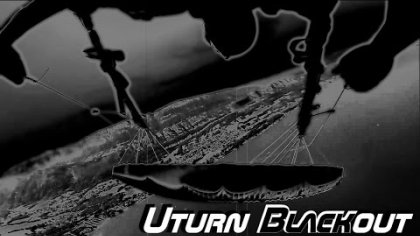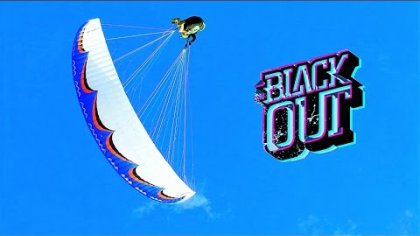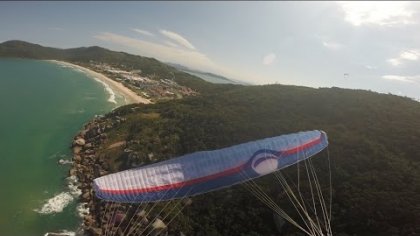19 years ago
Description:
The Helicopter is actually a controlled Spin, whilst the glider is totally open, the pilot is straight under the wing, and the rotation is stable (the wing turns like the rotor of a helicopter). The sinking rate is quite low, around 2-3 m/s.
This is one of the most difficult manouvres, which requires very precise brake handling from the pilot. If you really want to learn this trick, you have to go for it, and forget to practice everything else!

Preparation:
To prevent riser twisting, set your harness to sitting position, release the chest strap as much as possible, put your legs under your harness and be ready to turn with your glider.
Enter:
This manouvre is extremely sensible for turbulences, especially during the entering. Try to practice only in completely calm air.
In the following text I describe a Helicopter to the right:
Slow down the glider to minimum speed by gently and symmetrically braking. Once it stabilized over you (doesn’t swinging anymore), apply just a little bit more brake to get the glider into deep stall (the brake pressure gone and the glider loose it’s horizontal speed). When the canopy is completely above you and the descending is stable, release the left brake, grab the left riser, and just keep the right brake (or pull only few centimeters more) at the same moment. Just after the the glider starts the rotation, gently release the right brake almost completely, until the point where you feel the brake pressure starts to increase and the Helico became stable. Usually you have to pull only 5-10 centimeters to keep the glider in Helicopter. If you pull too much brake, the wingtip will collapse.
If during the entering the glider starts to turn a little bit in front, the deep stall was not strong enough (you didn’t brake enough). In this case, you may also have to pull a little bit more on the negative side to start the rotation (and it’s not ideal). Shift your weight to the negative side until you swing back under the glider, than return to the center.
Also take care not to pull to much brake in the deep stall, otherwise the glider gets a little bit behind you (as it starts to slide backwards) and that’s also not a good position to start.
In the Helicopter you can play also a lot with your body. Not only the handling of the brakes, but the right weight-shifting is also important. Above all, at the beginning of your practice the best what you can do is to stay in the center. You also have to learn how to control your body if the rotation is unstable, because you can easily generates big oscillation just by wabbling in your harness from one side to the other and moving your hands (and the brakes!) up and down anawares, cause even few centimeters can makes huge difference!
In a stable Helico, you can increase the speed of the rotation by gently shift your weight to the positive side.
There are only few pilots in the world who are able to correct an ugly Helicopter and switch it to a perfect one. It’s not really an exact knowledge, more like a sense, what everyone has to discover by itself. Especially because the right technique can be different, depends on the glider. But it will come gradually and spontaneously for sure, by hard traning, after hundreds and thousands of Helicopters.
But basically, if the rotation is unstable try the following technique:
Gently pull a little bit on the outside brake to slow down the rotation. When the glider is turning slowly, it calms down and it’s easier to stabilize. Than when the glider is straigt above you, try to find the right moment and accelerate it again by releasing the outside brake slowly. Of course in the meanwhile, right weight-shifting can also help a lot.
Exit:
If the rotation is stable, it’s very simple to exit. Just center your body, release the brake and control the following surge, which is usually a bit asymmetrical.
You can also exit by pulling down the outside brake (but don’t stall it!) and release the negative a little bit, until the glider stops. Than let it shoots forward and brake the surge.
At the beginning the safest way could be to pull down both brakes and Full Stall the glider. Gradually you will get the feeling how to exit safe even from the ugliest Helicos (or Spins) without stalling the glider.
All dangers of Spin Be very confident with Spins and Full Stalls before you try this manouvre. Because the glider has no horizontal speed in Helicopter, the stall point is located higher on the brakes, so you have to make only very gently and short brake inputs not to overreact.








Latest Comments
Hi Pal,
can you explane me what is the negative (bad) side of using brakes without pulleys?
What can goes wrong?
Thanks
Best regards, Peterka
Caveman, or someone else, Could you repost an image of the Quick-Outs setup or send me a link to it. fieldmod@dahlendesigns.com Thanks dzp
Thank you very much Pal for the tip!
I bought the Twister 18 and now I can do helicopters again. They are not perfect like yours, but I am working on it...
Let me ask you something more about the helicos, after all this forum is tho only place where I can get a little technical information, so here it comes: I didn´t understood those imputs brakes in the side that is flying regularly in the helicopter. I can see that you and others pilots use it to mantain the glider in the axis or to correct the glider when it is going out of the axis, but when is the right time to use those brake imputs? Is it when the canopy (the side that is flying foward) is going in front of you or a little before that? Usually I try to release a little the brake in the side that is flying backyards to make smaller the drag on that side and find the right pressure, but I am still in doubt how and when to use the other brake.
Could you help me with that too? I think is a basic doubt of all acro pilots that is coming to an intermediate level.
Here in Brazil the only guy who used to give me good technical informations was Marcelo Borzino, but he was stopped with flight last year because of an accident... until recently, I heard... and I am trying to contact him again... Hey Marcelo, show up my friend!
Thank you very much Pal and I am trying to arrange things to go to Malcesine in september to see you and Gabor in the podium. Probably I can learn a little by ´osmosis`... :)
Soft Landings to all!
Hi Daniboy!
I can tell you that the Twister is way easier for helico then most of the acro gliders in its class.
When you enter from parachutal, do not brake that side more, just keep your hand there and release the other one. Man, helico is maybe the most difficult maneuver to master, but once you get it you make no more mistake!
10 attempt is like nothing to get used to a new glider, keep on training!
Pal
Hi daniboy,
If you want, i can give you a very nice tip:
Buy a Sonic2 from Sol
;o)
Hi Gabor, Pal and everyone,
I am close to buy a Twister but I have some questions on it, specially in helicos.
I tested the twister this weekend and I felt great into dynamics manouvres. I tryed the rithmic and I had a good surprise on it, even if I am not an expert on this manouvre.
But I just couldn´t put the canopy into the helico!
I don´t know... probably I am for a too long time with the same glider and doing the entry in the ´´automatic mode`` and not thinking about the dinamics.
I can stop the glider and put it into parachutage completally open, right over my head, but when I pull a little the brake in the side I want to go back and release the other side, the glider goes for the rotation out of the axis completaly!
I even tryed to leave the glider fall a little more before I put my hands up and wait the moment that I am right above the glider to try the entry pulling one brake a little and releasing the other. I failled into this way too...
Please help me to find a way to put the twister in helico, because I can´t buy a glider that I can´t put it into a plain helico... maybe I will have to go back to the basics with an easier glider... I am used to do simple helicos for a long time and this weekend I did about 10 attemptions and nothing...
Tips are very welcome from everyone, please!!!
I think until you learn how to enter nicely it helps to watch the glider. Once you are in stable helico you can look around, check the horizont, your sinking, the rest of altitude. With practicing more you will be able to listen to different things in the same time.
According to my experiences after a while you have to make slight corrections even on the most stable helico if you want to keep it for a long time.
Gabor
Thanks Gabor!
I think I will try to enter it from full-stall to deep-stall next time like you suggest. Then maybe practice the deep-stall afterwards.
Everyone tells me this is a hard trick to learn which is why I want it so much!
When I did my first helicopters in May I found that when it was "in" I found it was easy to maintain it but I have no idea what I was doing with my brake inputs, I just did what felt right and I wasn't watching the wing.
Do you prefer to watch the wing or the scenery in helis? I have heard different opinions from different pilots. I think I found it easier not to look at the wing to get a better idea of my orientation.
Jason
I think the key to learn the basics of helico is to know how to get deep stall precisely. There are different ways and styles to enter. If you slow down from trim speed you should pull the brakes quite deep for one moment to really stop the glider to fly. Just at the moment you feel the glider starts to slide backwards and the sound of the wind stops in your ears, you should release some brake to avoid full stalling the glider and try to maintain the shape of the canopy. The goal is to have a non flying but totally opened canopy exactly above your head. Not a bit in the back, not in front, totally above you. This is very hard to get because deep stall is a pretty sensible maneuver but if you can do this you just touch one brake and the glider starts to helico.
It’s also nice to practice the parachutal from full stall. After you fullstalled the glider you start to release both brakes slowly and check the canopy. With the symmetric releasing of brakes you will see and feel that the pulsation of the full stall gets smaller and smaller, it goes into a tail slide, 1-2 cm more and finally both wingtips open but glider is still not flying. Before releasing one side completely to start the first rotation you should wait for the perfect moment to have the middle of the canopy totally above you…
Just practice as much as you can. Helico is one of the most difficult maneuvers to learn.
Happy training!
Gabor
Hi Jason!
First of all what I see on your movie is that you didn’t stall enough the glider. It was still flying (just a little bit very close to the minimum speed) when you spinned it. If you enter like this the first rotation already has a small oscillation.
The other important thing is to release more! If you see your wingtip closing on the negative side after you spinned the glider, you have to start to release slowly the brake on the same side until you see that the canopy is totally open. At the same moment you will feel the brake pressure coming back. That’s the point where you should keep the brake smoothly. Like this your helico will rotate faster and sink less.
...
Hi!
I did my first helicopters in May in Oludeniz. Some were ok, others failed but overall I was pleased. I tried lots of times again in October in Oludeniz to do them too but I found it harder than in May. I'm not sure how long to stall the wing...
Here's a very low quality clip of one of my better May attempts:
http://www.marksparaglidingpages.com/heli2.wmv
I know its not graceful yet but did I stall it right? I can work on brake pressures to make it better but the entry is what I find hard to initiate.
I will post other failed attempts too soon. I want to know if I am deep-stalling too much or too litle? Recently when I tried, a paragliding friend (Arjan) thought maybe I was stalling too much? In my failed attempts, when I release the +ve side it does not accelerate very quickly and slightly dives -it seems there is not enough energy in the rotation to keep it going for more than 1-2 rotations.
Please help! I really want to get this trick.
So to recap... How deep is the deep stall. Just an instant or longer. I know that experience pilots can do it dynamically but I need to know what works best for learning...
Thanks very much.
Jason Andrews
Hi!
If you want to try it, maybe this picture can helps.
galeria/kep.php?kid=1633 kepek/200604131552535715_my_brake/my_brake_k.jpg Click to enlarge
Good luck and tell me your impressions!
Pal:
Thanks for your response. What you say makes a lot of sense. I may try it this weekend. Great site!.
Best regards
Mark
Hi Mark!
If you look carefully you will notice that the brakeline doesn't go trough a pulley, it is totally coming free from the canopy to my hands. That (elastic) line is only to fix the brakes to the riser of the glider (not to the quick out), so you can release the brakes without loosing them :-)
I saw some pilots (like Raul, Félix, Pablo) flying with this system at the acro competitions in august. After the comps we went to Spain for training so I decided to try this system. After 1-2 days I became familiar with it and I could do all the maneuvres again. I didn't feel the huge difference until I flew a glider with pulleys, weeks later. Than I realized how many (lots of!) information just simply lost because the line goes trough the pulleys and you doesn't really feel what's happening with the glider, but how the the pulley is rolling. It's almost impossible to pull the brake without breaking the linear of the line so you feel this all the time. For example it's very nice to do Helicopter with it which is a very sensible maneuvre and needs lots of precision.
I found only one disadvantage of the system, but after few mounths it already dissappeared: ground handling. At the beginning it's a bit tricky to take off, because the brake doesn't have a fix place so you have to practice with it.
I think this system is excellent not only for acro, but thermalling as well.
If you are interested, I can upload a picture about it.
In the twister video, there seems to be a line going from the pilots hand to the quick out. What is this and what is it used for? It almost looks like it is attached to the protective cover on the quickouts.